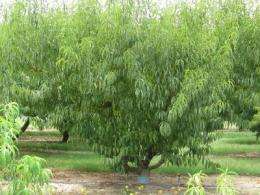Researchers sequence peach tree DNA

As peach trees go, it doesn't look much different than its kin at the Clemson University Musser Fruit Research Farm, but appearances can be deceiving. This one, a Lovell variety, has a unique genetic characteristic that made it a standout in the orchard. Its DNA -- its genetic set of instructions for living -- has been sequenced by scientists, enabling further research to identify beneficial traits to grow better trees and fruit.
The tree's DNA sequence is being published worldwide April 1, opening a new era in fruit-tree research that could have far-reaching implications for the future of peaches, as well as many other valuable plants. The research is available online at www.peachgenome.org .
This genome sequence is the culmination of an extensive research program pioneered at Clemson University under the leadership of Albert "Bert" Abbott, who holds the Robert and Lois Coker Trustees Chair in Molecular Genetics and is a professor in the genetics and biochemistry department. The research goal is to establish the peach as a model tree genome for identifying and understanding genes that are critical for deciduous tree growth and development.
"The tree providing the DNA for the sequencing effort was chosen after careful analysis of DNA from specific trees in the Musser orchard," said Abbott. "The choice of this tree was crucial to the overall success of the project, and the extremely high quality of the peach genome sequence assembly is a direct result of this choice."
The peach genomics efforts of the Clemson research team and its international collaborators led the Joint Genome Institute, a federally funded sequencing facility, to underwrite the sequencing the genome of peach as one of the key plant species of interest worldwide.
Clemson and Washington State University maintain the Genome Database for Rosaceae, which is a central repository of genetics and genomics data of Rosaceae, an economically important plant family, including apple, cherry, peach, pear, raspberry, rose and strawberry.
Clemson has a close connection to Washington State through Dorrie Main, a WSU associate professor of bioinformatics. She previously was director of bioinformatics at the Clemson University Genomics Institute, a research and training facility focusing on the discovery and analysis of important genes from plants, animals and microbes.
Bryon Sosinski, a graduate of the Clemson genetics program, now an associate professor of horticultural science at N.C. State University, served as the American coordinator of an effort to sequence the genome of the peach. Sosinski said the effort spanned the globe, involving scientists in Italy, Spain and Chile. In the United States, N.C. State, the Joint Genome Institute, Clemson and Washington State universities were the principal partners. In the United States, the effort was funded by the U.S. Department of Energy, while the Italian government funded the international effort.
The peach genome should be useful to scientists working with a number of peach relatives whose genomes appear to be similar to that of the peach, according to Sosinski.
"Some of these relatives, such as apple or plum, might be expected, but others, such as strawberries and raspberries, and trees, such as poplar and chestnut, would seem unlikely in that the plants are quite different from peaches," he said.
It is likely, Sosinski added, that all these plants had common ancestors, and that while they have evolved to be quite different today, their genetic makeup remains similar. As a result, what scientists learn about the peach genome may transfer to these relatives, as the peach genome appears to be relatively unchanged or ancestral in nature. If, for example, scientists identify a peach gene that influences sugar content in the fruit, strawberries and raspberries may have that same gene and it may have the same function.
While sequencing the genome of an organism is a significant scientific achievement, Sosinski said, it is just the beginning of scientific work related to the genome. The genomic sequence of an organism is roughly equivalent to a book that is simply a long list of letters, without spaces between words or punctuation, paragraphs or chapters.
This long list of letters, by itself, has little meaning; however, if the letters are organized into words and punctuation added, creating meaningful sentences, paragraphs and chapters, the book begins to make sense, said Sosinski.
At the Musser farm in Oconee County, S.C., researchers field test more than 350 different types of peaches, including varieties from Italy, China and France. Some of them will perform well in South Carolina; others will not. The goal is to provide peach growers with research-based information so that they can make good decisions for a profitable industry.
"Consumers are becoming much more aware of the health benefits associated with varieties optimized for nutritional value," Abbott said. "The stone fruit industry in South Carolina and the nation faces many significant challenges. These varieties will help growers gain a competitive edge in the marketplace."
Arrangements have been made to send 10 cuttings of the DNA-sequenced tree to N.C. State, where Sosinski hopes to plant the trees around campus.
Provided by Clemson University

















